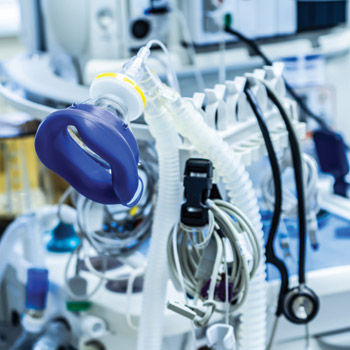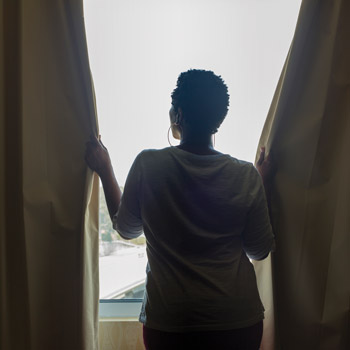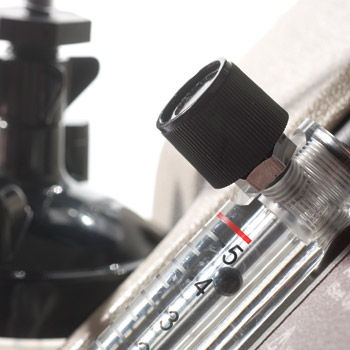Know your home oxygen options
Physicians, nurses, and respiratory therapists may be unfamiliar with home oxygen equipment that differs from hospital equipment. Six questions can help clinicians choose the best options for a patient.
Patients discharged on portable home oxygen often don't get the type that would best meet their needs, according to Thomas J. Kallstrom, MBA, RRT, executive director and CEO of the American Association for Respiratory Care in Irving, Texas.

“As we look at patients that are on home-going oxygen, we know that many clinicians, physicians, nurses, [respiratory] therapists are unfamiliar with equipment that might be used in the home. They may be very familiar with the hospital equipment, but not home equipment,” he told his audience at the American Thoracic Society's virtual meeting, held in August. He suggested that clinicians keep the following questions in mind when deciding which home oxygen to prescribe:
- How portable is the patient? Is oxygen required while ambulating?
- Are there limits on how much the patient can lift or carry?
- What is the flow rate?
- How many hours a day does the patient wear oxygen?
- Is the patient adherent to current oxygen therapy?
- Does the patient leave the house or travel with oxygen?
One final question is whether the cost of the device is adequately covered. A patient may qualify for Medicare coverage of a portable oxygen system either by itself or used with a stationary system, and Medicare documentation must indicate that the patient is mobile in the home and would benefit from portable home use, Mr. Kallstrom noted. Portable oxygen is not necessarily covered for use only as a backup to a stationary oxygen system or for patients who qualify for oxygen solely based on blood gas values obtained during sleep, he added.
Once these questions are answered, it's time to pick an oxygen delivery system. Mr. Kallstrom offered an overview of the types available, as well as their pros and cons.
Oxygen tanks. This is the most common oxygen delivery system seen in the hospital, Mr. Kallstrom said, and these devices are also often seen in the home. “They function pneumatically by slowly releasing pressurized oxygen at a specific liter flow for the patient,” he explained. Cons of this system include limited volume; at a rate of a liter or two per minute, a cylinder will last only five hours. “If a patient is leaving their home for a trip to the doctor or to the grocery store or to visit somebody, oftentimes, this 5 L might not be enough, especially if they don't leave the home with a full tank,” he said.
This system is also heavier than other devices, and tanks need to be returned to the factory to be refilled. “The inconvenience of compressed oxygen tanks in part explains why patients use only 45% to 70% of the oxygen prescribed: because they're bulky and oftentimes not preferable for our patients,” Mr. Kallstrom said. Although tank systems are still very common, they're beginning to be replaced by portable oxygen concentrators, he noted.
Self-filling oxygen concentrators. These provide both portable and stationary oxygen, Mr. Kallstrom said. “Patients can use the portable tank when they leave the home, and oftentimes patients find that very convenient.” Downsides include that they require electricity—”To run this unit just as a stationary oxygen concentrator, you will see an increase in your electric bill,” Mr. Kallstrom said—and that the amount of oxygen in the portable unit is limited. “Again, know what the liter flow is and know how long we will have with a full portable tank from one of these units,” he advised.
Stationary oxygen concentrators. “These are stationary units that essentially take the air in the room and they filter out everything except oxygen,” Mr. Kallstrom said. “Once filtration occurs, you're not getting exactly 100%, but you're getting maybe 90% to 95%, maybe close to 100% purity when you use these units.” One big plus is that they don't need to be refilled, Mr. Kallstrom said, “but some of the cons are that you can only really use them in one location, which would be your home.” Patients using these devices sometimes use a long extension to their nasal cannula to move the device around the house, but this typically should not extend farther than 50 feet, he said. Other cons include the cost of electricity and the fact that some units can be noisy.
This choice also requires maintenance. “We want to make sure that someone comes up to verify that the oxygen levels are within specs,” Mr. Kallstrom stressed. “Sometimes you may not know that with these machines, because you'll see the unit bubbling water in the humidifier. … That may make the patient think everything's fine, but in fact, it might not be if it's still delivering a low level of oxygen.” This type of unit also has internal and external filters that require changes, and it's a good idea to have a backup method in case electricity goes out for any period of time, Mr. Kallstrom said.
Portable oxygen concentrators. These devices, which have been available for about a decade or more, run on rechargeable batteries, which patients should make sure are fully charged before they leave the home, Mr. Kallstrom said. They are the only type of portable oxygen devices currently allowed on airplanes. “Depending on the flow, there's limited oxygen availability, so generally the purity is about 90% to 95% in these devices,” he noted. “One thing that is important to know is that these devices do not work off of liter flow, but rather there's a number on the machine that the patient is titrated to, so you want to make sure that you're at the right number. So if you're in the hospital at a liter flow of 2 L per minute, it does not necessarily equate that the No. 2 setting on your portable oxygen concentrator is 2 L, so that's something to remember.”
The appropriate setting will depend on the device, he cautioned. “If I have two different manufacturers making this device, a setting of No. 5 on one device will not necessarily equate the same level of delivery at 5 that the other one would. So again, it's important that we titrate and make sure that the patient is getting adequate oxygen based upon that number.”
Liquid oxygen units. These systems can be refilled at home and have portable reservoirs, so patients can remove them from the base and leave home with them. The flow rate is up to 15 L a minute, and the oxygen is 99% pure, “like oxygen coming out of the wall in the hospital,” Mr. Kallstrom said. The downsides are that refills are required periodically from the durable medical equipment (DME) company because gas evaporates from the unit over time, and there is also some risk for thermal injury. In addition, liquid oxygen units have become difficult to get, decreasing in availability by 82% from 2010 to 2016 due to competitive bidding pricing, according to Mr. Kallstrom. “For DMEs to use liquid oxygen units, the profit margin has pretty much been obliterated because reimbursement is too low to allow them to recoup their loss when they use these expensive delivery systems, or very, very little profit,” he said. “So, what's happened because of that is that it's not available as much as we would hope.”





